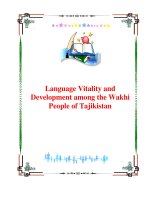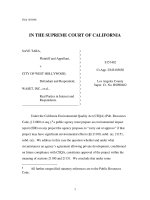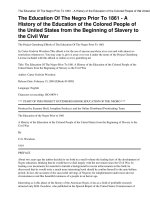4 1 the chumash people of california
Bạn đang xem bản rút gọn của tài liệu. Xem và tải ngay bản đầy đủ của tài liệu tại đây (3.77 MB, 10 trang )
THE
CHUMASH
OF
PEOPLE CALIFORNIA
Fascinating Facts
• Chumash people used fishhooks hundreds of
years ago.
• The Chumash paddled their canoes so far
out in the ocean that sometimes they lost sight
of land.
• Chumash hunters used wooden decoys to
hunt ducks.
Genre
Nonfiction
Comprehension Skill
Text Features
Main Idea and Details • Map
• Sidebars
Scott Foresman Social Studies
ISBN 0-328-14853-9
ì<(sk$m)=beifda< +^-Ä-U-Ä-U
BY
STEPHANIE SIGUE
Before the Mexicans and the Europeans
arrived in California, at least twenty thousand
Chumash lived in the southern part of the state
and on the Channel Islands. In this book you
will read about how they lived.
Write to It!
From what you have read about the
Chumash, write two paragraphs that
describe something about them that
surprised you. Tell what it was and why it
was a surprise.
Vocabulary
culture
hereditary
Write your description on a separate sheet
of paper.
site
mission
missionary
Maps
3 Mapquest.com
Photographs
Every effort has been made to secure permission and provide appropriate credit for photographic material. The publisher deeply
regrets any omission and pledges to correct errors called to its attention in subsequent editions.
Unless otherwise acknowledged, all photographs are the property of Scott Foresman, a division of Pearson Education.
Photo locators denoted as follows: Top (T), Center (C), Bottom (B), Left (L), Right (R) Background (Bkgd)
ISBN: 0-328-14853-9
Copyright © Pearson Education, Inc. All Rights Reserved. Printed in the
United States of America. This publication or parts thereof, may be used with appropriate
equipment to reproduce copies for classroom use only.
1 2 3 4 5 6 7 8 9 10 V0G1 14 13 12 11 10 09 08 07 06 05
Opener: ©Nik Wheeler/Corbis
6 ©Marilyn “Angel” Wynn/Nativestock
Editorial Offices: Glenview, Illinois • Parsippany, New Jersey • New York, New York
8 ©Marilyn “Angel” Wynn/Nativestock
10 ©Marilyn “Angel” Wynn/Nativestock
Sales Offices: Needham, Massachusetts • Duluth, Georgia • Glenview, Illinois
12 ©Reinhard Brucker/Westwind
Coppell,Enterprises
Texas • Ontario, California • Mesa, Arizona
13 ©Ian Shive Photography
14 ©Nik Wheeler/Corbis
OREGON
American Indians are Eskimos, Aleuts,
and other people who lived in North America
before the arrival of European explorers.
American Indians were the first people to
live in this country.
There are hundreds of American Indian
groups, but you may not have heard of some of
them. Some of the more well-known American
Indian groups are the Navajo, the Apache,
and the Cheyenne in the West and Southwest,
the Sioux in the Midwest, the Seminole in the
Southeast, and the Mohawk in the Northeast.
The Chumash, a lesser-known group, lived
in California.
Key
Present-day
national border
Present-day
state border
NEVADA
CALIFORNIA
PACIFIC OCEAN
ARIZONA
Chu
ma
Ch a n n
N
sh
el I
sla
nd
s
American Indian Names
Many geographic areas in the United
States have American Indian names.
The Teton mountain range, the states
Massachusetts and Delaware, and Lake
Huron, a Great Lake, are just a few of
these areas.
2
0
0
100
100
MEXICO
200 Miles
200 Kilometers
The Chumash lived in southern California along the Pacific Coast.
They also lived on the Channel Islands off the coastline.
3
The Chumash Way of Life
Scholars have studied the remains of the
Chumash culture to find out how the people
lived. They learned that the Chumash had a
three-class social structure. It was made up
of a lower, middle, and an upper class. The
Chumash also had craftspeople and groups of
specialists such as chiefs, doctors, and other
important people.
Most of the Chumash people belonged to the
middle class. Some were hunters, while others
prepared food. Another group made tools. The
people in the lower class lacked such skills. The
upper class was made up of families who did
have skills and lived throughout the territory.
What Does Chumash Mean?
The Chumash called themselves “the
first people” and thought of the Pacific
Ocean as their first home.
4
Each village had a leader. The most
important person in a village was the chief,
or wot. The title of chief was hereditary and
was passed down in the chief’s family. The wot
represented the village at regional meetings.
The chiefs would meet at council meetings to
discuss tribal business and to pass laws that
governed the entire group.
A chief had many duties. He or she decided
where the hunting grounds would be and gave
permission for other villages to hunt on his or
her village’s property. The chief worked with
the other chiefs to provide emergency food
and resources during disasters such as floods.
The chief also settled arguments between
neighboring villages, and, if necessary,
declared war.
The shaman, or religious leader, was also
important. He mixed plants and herbs to
cure aches, pains, and fevers. He might also
forecast storms.
5
A Chumash Village
Each Chumash village site was on flat land
near water, rocks, plants, and animals. The
Chumash needed rocks for tools and plants
and animals for building materials and food.
The site had to be safe from natural disasters,
like floods, and had to provide some protection
from the village’s enemies. Each village had a
space for ceremonial events, a playing field, and
a burial ground.
Villages were different sizes. A small village
might have as few as seventy-five people. A
large village could have as many as a thousand
people. The people in the village lived in
houses shaped like domes that were grouped
in clusters.
The Chumash built their homes from the
area’s plants and trees. Each house was about
fifteen feet in diameter and was tall enough to
stand up in. Wooden sticks were used to make
the frame. They then bent the poles inward and
tied them together to create the dome’s shape.
To complete the house, the Chumash wove
together mats made from bulrushes, or tall
grasses, and tied them to the frame. The mats
were between two and three inches thick and
were placed in a shingle-like pattern. The
thickness of the mats helped to make the house
waterproof. Each house had a door that was
made from whale ribs. In each roof was a hole
to let out smoke from the cooking fire.
Three children look at the inside of a Chumash house.
A Chumash Family
The Chumash lived in what are known
as extended family groups. This means
that several generations and branches
of a Chumash family lived together in
one home.
7
Living Offshore
The Chumash and Fishing
Many of the Chumash lived on San Miguel,
Santa Rosa, Santa Cruz, or Anacapa. These
islands are fifteen to thirty miles off the
California coast and are part of the chain of
Channel Islands.
To make the journey between the islands and
the mainland, the Chumash built plank canoes
called tomols. A tomol was a long, sturdy boat
that could hold up to fifteen people. The boat
was made from planks cut from driftwood. The
planks were sewn together with plant fibers and
animal hides. The joints were sealed with pitch
or tar. After the canoes were finished, they were
painted red and decorated with seashells.
Fishing was the main job of many Chumash
men. They had many ways to catch fish. They
attached fishhooks to a line and fished from
their tomols. They often used fish traps. The
Chumash also used nets to catch fish. The
Chumash diet also included shellfish, such as
clams that they collected along the shore.
The Chumash used spears, harpoons, and clubs
to hunt seals, sea lions, otters, and dolphins.
8
9
Hunting and Gathering
Hunting was a big part of a Chumash man’s
life. Large animals, such as deer, elk, and
antelope, were often hunted. Small animals,
such as rabbits and squirrels, were also hunted.
The Chumash were stealthy hunters. They
used duck decoys. They also sometimes put
smoke into burrows to force animals that lived
underground to come out. The Chumash often
used snares to catch small animals, while the
larger animals were killed with arrows or stonetipped spears.
Chumash Hunters
Chumash hunters had to get close to
the animals they were hunting because
their primary weapons were spears and
arrows. Wearing animal skins often helped
Chumash hunters
to close in on their
prey without being
noticed.
In addition to hunting and fishing, the
Chumash relied on certain plants for food. Oak
trees provided the Chumash with a plentiful
supply of acorns. All of the plant matter used by
the Chumash for food was gathered, not grown.
The Chumash were not farmers. The plants
they ate were all wild plants. In addition to
acorns, the Chumash people gathered pine nuts,
different types of berries, and cattail seeds.
The acorn was very important in the
Chumash diet. After acorns had been gathered,
Chumash women would mash the nuts and
pound them into flour. After the flour had
been cleaned, it was used to make different
types of food such as breadlike loaves. Because
acorns and other nuts were so important to the
Chumash diet, each household had a basket
granary, or a place for storing food, where they
would store nuts to eat during the winter.
In the winter they would pick a variety of
other plants and herbs. The Chumash did not
eat everything they picked. Many of the plants
they picked were used to make medicines.
11
Chumash Artifacts
The Chumash people demonstrated their
artistry in several ways. The women were some
of the finest basket makers in the world. The
baskets, made of plants similar to tall reeds, are
fine examples of beautiful workmanship. Many
of them have complicated designs woven into
the baskets’ fibers.
The men carved bowls, knife handles, bows,
arrow shafts, and needles from wood. Other
useful items such as knives, scrapers, and
arrowheads were shaped from stone. Fishhooks
were made from pieces of broken abalone
or mussel shells. The Chumash also carved
wooden flutes, whistles, and pipes.
This is a
Chumash gourd.
12
This is an example of a Chumash cave painting.
Chumash Rock
and Cave Paintings
Like most American Indians, the Chumash
had religious beliefs. Their beliefs can be seen
in rock and cave paintings that have been
found in remote mountain areas. Although the
subjects of the paintings are different, the style
is the same. One Chumash painting shows a
ship. Others seem to be figures that are based
on heavenly bodies.
No one really knows what the paintings
mean. Some scholars think that they are maps
or records of real events. Others believe that
they have a more religious meaning.
13
Chumash Festivals
Chumash and the Missions
The winter solstice, or the shortest day of the
year, was the most important event of the year
for the Chumash. There was always a festival at
that time. During such an event, people from all
of the Chumash villages would gather at a host
village. They would trade goods, play games,
dance, arrange marriages, see their friends, and
have fun.
At the festivals people
sang and danced. They
played team games along
with games that tested an
individual’s physical and
mental skills. Some
historians believe
that the cave
paintings were
made during the
winter solstice
festivals.
By the time the Spanish arrived in the mid1700s, the Chumash had a strong and growing
economy. It was during this period that the
Spanish began to build mission settlements
throughout California.
Because the Chumash were traders, they would
visit the missions to trade for European goods. The
Spanish missionaries encouraged the Chumash
to change their religious beliefs to Christianity.
The missionaries had the Chumash captured and
forced them to live and work at the missions.
Life at the missions was harsh. The Chumash
were overworked and underfed. Because they had
never had European diseases, thousands of them
died because they lacked immunity. When the
Chumash tried to escape, their struggles failed.
Today 287 Chumash live on the small Santa
Ynez Reservation in California, and about 2,000
people claim Chumash ancestry.
Chumash Population Decline
In 1775, as the missionaries were just
beginning to arrive, the Chumash population
was twenty-two thousand. In 1885, one
hundred years later, only eighty-four remained.
By 1906 only forty-two were still alive.
14
Before
the Mexicans and the Europeans
Glossary
arrived in California, at least twenty thousand
culture the way of life of a particular
Chumash lived in the southern part of the state
people including customs, religion, ideas,
and on the Channel Islands. In this book you
inventions, and tools
will read about how they lived.
hereditary passed down from parents
to children
Write to It!
From what you have read about the
Chumash, write two paragraphs that
describe something about them that
surprised you. Tell what it was and why it
was a surprise.
mission a settlement
set up to teach religion
Vocabulary
missionary a personculture
sent by a religious
group to spread its
religion
hereditary
site a place where something
is located
site
Write your description on a separate sheet
of paper.
mission
missionary
Maps
3 Mapquest.com
Photographs
Every effort has been made to secure permission and provide appropriate credit for photographic material. The publisher deeply
regrets any omission and pledges to correct errors called to its attention in subsequent editions.
Unless otherwise acknowledged, all photographs are the property of Scott Foresman, a division of Pearson Education.
Photo locators denoted as follows: Top (T), Center (C), Bottom (B), Left (L), Right (R) Background (Bkgd)
ISBN: 0-328-14853-9
Copyright © Pearson Education, Inc. All Rights Reserved. Printed in the
United States of America. This publication or parts thereof, may be used with appropriate
equipment to reproduce copies for classroom use only.
1 2 3 4 5 6 7 8 9 10 V0G1 14 13 12 11 10 09 08 07 06 0516
Opener: ©Nik Wheeler/Corbis
6 ©Marilyn “Angel” Wynn/Nativestock
8 ©Marilyn “Angel” Wynn/Nativestock
10 ©Marilyn “Angel” Wynn/Nativestock
12 ©Reinhard Brucker/Westwind Enterprises
13 ©Ian Shive Photography
14 ©Nik Wheeler/Corbis









